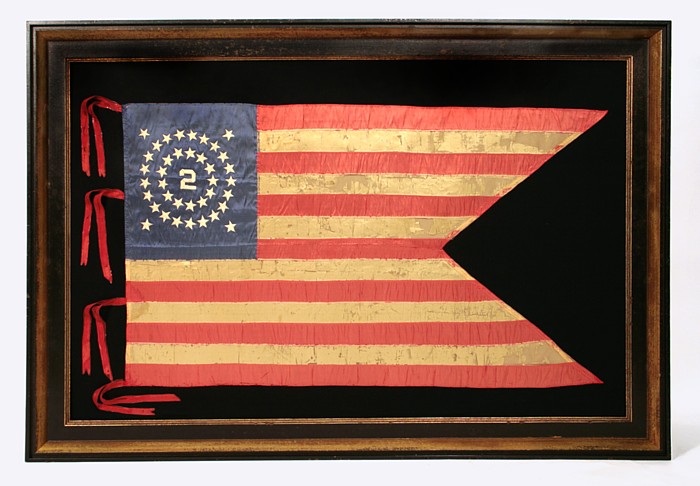
| |
38 STAR ANTIQUE FLAG, A SWALLOWTAIL GUIDON OF THE 2ND MASSACHUSETTS OR NEW YORK CAVALRY, 1879 SPECS, EXTRAORDINARILY RARE |
|
| Available: |
Sold |
| Frame Size (H x L): |
Approx. 33.25" x 52" |
| Flag Size (H x L): |
23.5" x 40.5" (plus ties) |
|
| Description....: |
|
38 star American national flag in the form carried by the United States Cavalry beginning in 1862. It was in this year that regimental guidons took the form of the national colors instead of a two-stripe, red-over-white flag in the same swallowtail format. This particular guidon is unusually long and narrow when compared to all other examples I have seen. It most closely matches the 1879 regulation guidons adopted by both the 2nd New York and the 2nd Massachusetts Cavalry regiments, and could have been carried by either one of these two units.
Although there was little standardization across the Union Army’s use of regimental colors during the Civil War period, Stars & Stripes format cavalry guidons were among the most universal in their general design. Their fabric was silk and their stars are typically applied with gold or silver metallic paint. Post-war, when the Cavalry went west to fight the Indian Wars, the silk fabric remained quite the same but embroidered stars are often seen in place of painted. That is the case with the stars of this flag, which are embroidered with silk thread. Their configuration is in the form of two consecutive wreaths, with a flanking star in each corner, and a numeral “2” embroidered in the open center of the medallion pattern to identify the regiment. Like earlier guidons, both the canton and stripes of the flag are made of fine silk that is pieced with treadle-stitching. Along the hoist there are four sets of ties, made of silk ribbon, that were used to affix the flag to its staff. Guidon staffs were made of wood and were generally nine feet in length, capped by metal finials. They were carried in a leather boot or pocket that was strapped to the off-side of the horse’s saddle.
Infantry national and regimental colors generally measured 6 feet x 6 ½ feet and were too unwieldy for horseback. Cavalry flags were small, however, regimental colors measuring about 2 feet x 2 ½ feet and company guidons about 40” in length, incorporating the swallowtail design to minimize wind resistance when riding horseback. For a collector of antique Stars & Stripes, post-1861 U.S. Cavalry guidons are particularly nice because of their specific and highly interesting history of use, their striking graphics, and because their size is large enough to make a statement yet accommodating to most places in a house or office where someone might wish to display a framed flag.
The 38th state, Colorado, gained its statehood on August 1st, 1876. The flag was official from July 4th, 1877 – July 3rd, 1889. Because flag-making was a competitive venture, no one wanted to be making 37 star flags when others were making 38’s. Flag makers paid little heed to official star counts, and would have begun producing 38 star flags for the Nation’s Centennial sometime in 1875 or the early part of 1876.
Mounting: The flag has been hand-stitched to 100% cotton, black in color that has been washed to reduce excess dye. n acid free agent was added to the wash to further set the dye and the fabric was heat-treated for the same purpose. The flag was then placed in a black-painted, hand-gilded and distressed Italian molding. A shadowbox was created to accommodate the silk ties, which were mounted in a 3-D folded format. The front is u.v. protective plexiglas.
Condition: The condition of the flag is excellent given its manner of construction, date, and purpose. After about 1850, silk was sold by weight instead of length. Mineral salts, among other things, were added to the fabric by merchants to make it heavier. This proved caustic to the fabric over time. If you have ever walked into an armory and seen the state of Civil War period and other post-1850 silk flags rolled on their staffs and displayed in glass cases, know that a combination of hard outdoor use, manner of storage, and weighting agents account for their present condition. More often than not, the flags are nearly destroyed. That is why the condition of this flag is superior to most known examples.
Losses in the white stripes of the flag and breakdown in the scarlet red ribbon ties were contained and stabilized by means of a translucent fabric that was applied to the silk with heat by a textile conservator. This is archival and reversible. 100% silk of similar coloration was placed behind the flag to strengthen its color against the black background. This also acts as a barrier between the flag and the background fabric. |
|
|
|
| Collector Level: |
Flags for the truest Patriots. My best offerings |
|
| Flag Type: |
Sewn flag |
|
| Star Count: |
38 |
|
| Earliest Date of Origin: |
1879 |
|
| Latest Date of Origin: |
1879 |
|
| State/Affiliation: |
Colorado |
|
| War Association: |
1866-1890 Indian Wars |
|
| Price: |
No |
|
| |
Views: 4263 |
|
|
|

